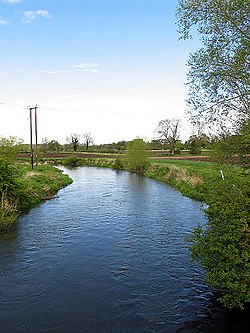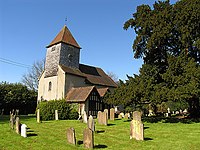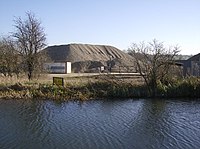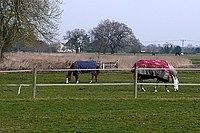Padworth
| Padworth | |
| Berkshire | |
|---|---|
 The Kennet from Padworth Bridge. | |
| Location | |
| Grid reference: | SU619661 |
| Location: | 51°23’35"N, 1°6’50"W |
| Data | |
| Population: | 919 (2011) |
| Post town: | Reading |
| Postcode: | RG7 |
| Dialling code: | 0118 |
| Local Government | |
| Council: | West Berkshire |
Padworth is a scattered village along the River Kennet, by the southern edge of Berkshire, close to the border with Hampshire. This is a lightly populated locality and the nearest town is Tadley in Hampshire.
The largest knot of houses in Padworth parish is not Padworth itself but Aldermaston Wharf, which is beside Lower Padworth, north of the Kennet. Aldermaston railway station stands here. The heart of Padworth itself, if it can be called that, is a scatter of separated cottages and farms in the lanes south of the Kennet and north of Grim's Bank; the parish church is in this area. Aldermaston Wharf is to the north and Padworth Common to the south.
The southern bounds of the parish meet the county boundary, beyond which lies Mortimer West End, in Hampshire. The south of the parish is wooded towards its edges and the north of the parish is agricultural with a hotel beside the Kennet and Avon Canal. In the centre of the parish is a school, Padworth College, which is a Georgian manor house, built on the site of a much older manor house.
About the village
Padworth proper is centred upon the little Norman church and the old manor house, from 1748 home of the Darby-Griffith family but in the 20th century converted into Padworth College, an independent co-educational boarding and day school for students aged 13–19.
- Lower Padworth and Aldermaston Wharf are concentrated along the A4 Bath Road. Aldermaston Wharf is by far the largest place in the parish; a nucleated village of itself. Aldermaston railway station is here.
- Padworth Common sometimes describes all of the scattered south but strictly speaking only includes land outside of the farmland of the former manor centred on the site of Padworth College.
Padworth has its southern boundary with Mortimer West End, Hampshire. The south of the parish is wooded towards its edges and the north of the parish is agricultural with a hotel beside the Kennet and Avon Canal.
Economy
A 'fishery in the Kenette' was among the possessions of the manor in 1586, and a fishery is mentioned as early as 1378. The fish-pond north of the old manor house (now a school) is a Scheduled Ancient Monument.
The local economy in the 1920s centred on the chief crops: wheat, barley, oats and roots.[1] These remain regular crops in Padworth alongside hay meadows for livestock, horses and donkeys.
Gravel extraction, education, agriculture, transport and tourism provide jobs in Padworth itself. Aldermaston railway station next to the village's hotel at Aldermaston Wharf serves two of these sectors. Commuting to Reading, Newbury and other local is the most common source of employment as at the 2011 census: Reading and Newbury are each about 20-30 minutes away by road and by rail. Tadley across the border also provides a major source of retail, leisure and general high street service employment, the nearest town.
Parish church
The parish church is St John The Baptist. It is a small, aisleless church, built about 1130.
The church has with two three-light Tudor windows, ornately carved. A smaller Tudor window has two lights on the southeast square tower façade. The roof of the nave was largely replaced in the 19th century.[1] Rare features include the Norman chancel arch and north and south doorways, the semi-domed apse and the 18th-century monuments.[2] St John's is Grade I] listed.[3]
The parish is part of the united benefice of Stratfield Mortimer, Mortimer West End and Padworth, which has four churches and two church schools. The church alternates its Sunday service between 9 am Eucharist and 6.30 Evensong.[4]
History
Grim's Ditch runs from the mid-south of the area half a mile into the southern forest of Ufton Nervet. It is believed to be Dark Age work; a bank and ditch dug to defend Calleva Atrebatum (Silchester Roman Town) when the ancestral English began to settle the area.
The place is recorded in such documents as the Assize Rolls and national Feet of Fines (on property sale) as Peadanwurthe (10th c.); Peteorde (11th c.); Pedewurth (12th c.); Padewrd, Padworze (13th c.); Padesworth, Pappeworth (14th c.).[1]
Outside links
| ("Wikimedia Commons" has material about Padworth) |
References
- ↑ 1.0 1.1 1.2 'Parishes: Padworth', in A History of the County of Berkshire: Volume 3 ed. P H Ditchfield and William Page (London, 1923), pp. 413-417. Accessed 10 December 2014.
- ↑ |Betjeman, John, ed. (1968) Collins Pocket Guide to English Parish Churches; the South. London: Collins; p. 114
- ↑ National Heritage List 1155386: St John's Church, Padworth
- ↑ Stratfield Mortimer and Mortimer West End Benefice: Parish of Padworth (St John the Baptist)


